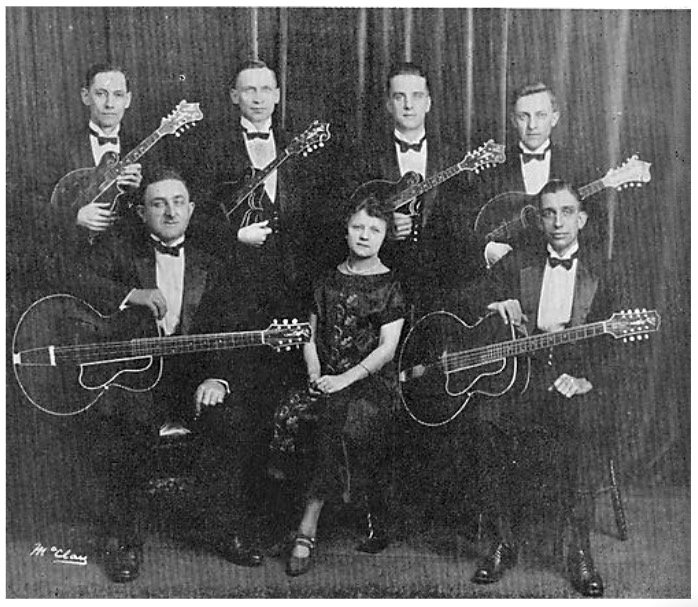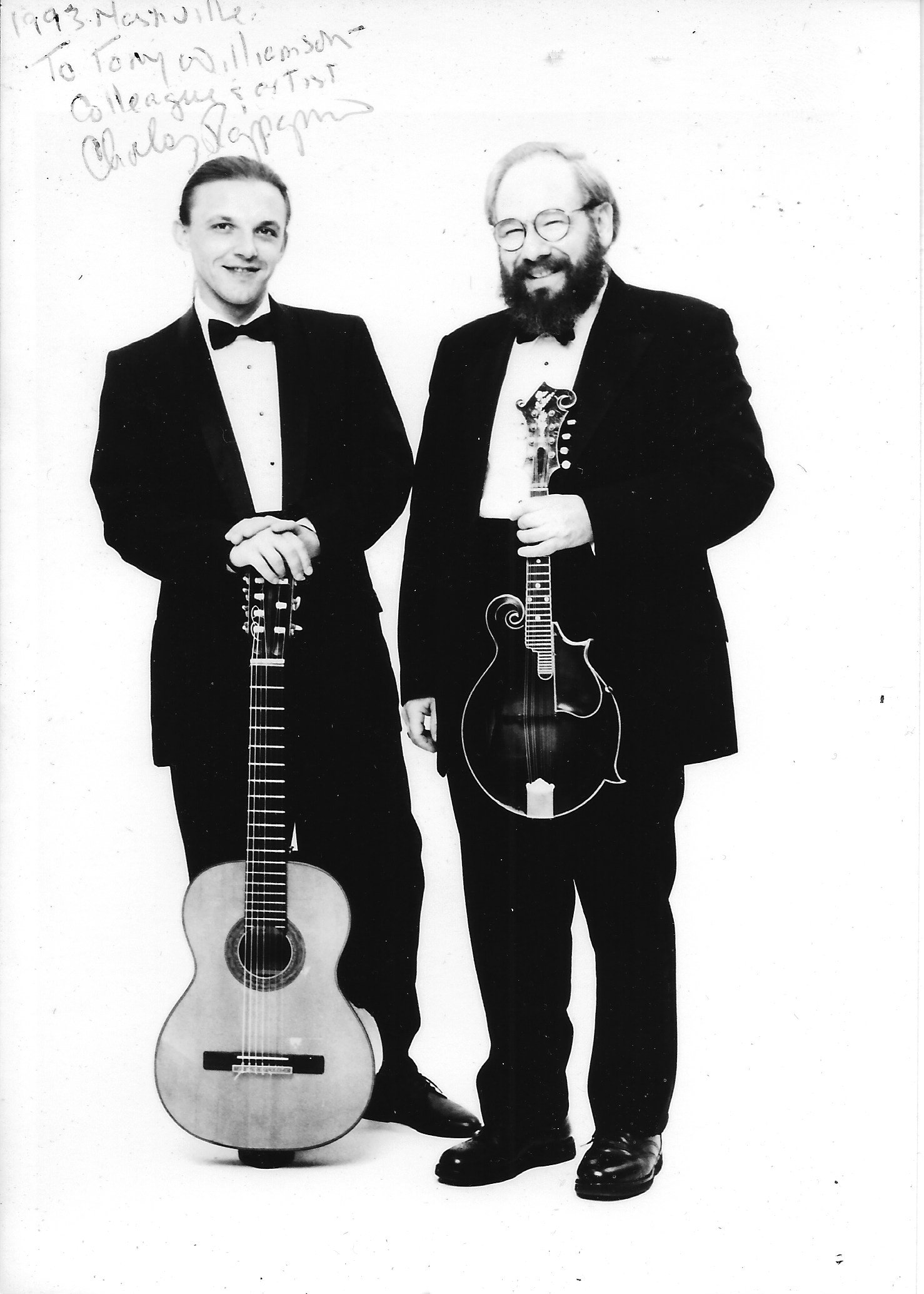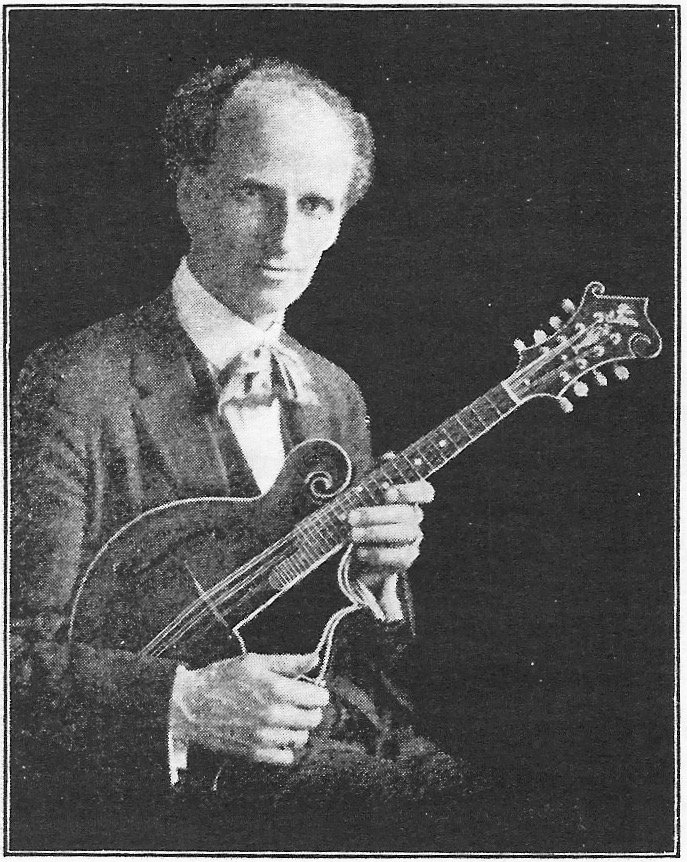The Allegro Mandolin Sextet, 1923. Front row: Alec Jay Stright; Flora K Lichtenfels; Adolph B Fox. Back row: Charles M Dunford; Percy V. Lichtenfels, Director; Paul, A Wibel; and Edward P Green. On June 23, 1923, in a landmark development in the history of radio, their program was the first to be broadcast overseas; on that live radio concert, Mr. Lichtenfels played Gibson F-5 73679, signed by Lloyd Loar and dated June 13, 1923.
In June of 1923, we have reports of fifteen F-5s and one L-5 made; there is the possibility that more might be discovered. Some of those mandolins, in the hands of master musicians, went on to significant contributions to the history of American music. One F-5 was played in Pittsburg and heard in Europe, and another was the first F-5 to be recorded. Before we explore these remarkable landmarks, however, we would be remiss if we did not first examine a detail of some significance to students of the Loar signed instruments.
Gibson F-5 dated simply “June 1923” signed Lloyd Loar. A black stripe appears on the side for the first time.
F5 #73682. With the black stripe of the binding on the side, the top and back have a different look.
Signature label on 73682.
This very interesting F-5, #73682 is signed simply “June 1923,” the only Master Model instrument signed by Lloyd Loar with no particular day specified. It is a magnificent sounding and beautiful mandolin, but for those interested in understanding more about the process of construction, the most curious thing about it is the deep binding channel along the side which made way for the first appearance of a black binding stripe. All previous F-5s feature a stripe on the top, not on the side.
Gibson F-5 73675 signed by Lloyd Loar, dated June 13, 1923. The typical F-5 look with stripe on top and back, none on side.
Why is this detail important? More to come…
Gibson F-5 73677, signed by Lloyd Loar, dated June 13, 1923. The first “wide fingerboard” F5.
The first side-bound F5 was not the only mandolin from June of 1923 with surprising features. Gibson F-5 73677, with factory installed Virzi Tone Producer 10124, signed by Lloyd Loar and dated June 13, 1923, featured a wider fingerboard. Long before Gibson introduced the “Sam Bush model,” there was this mandolin with the fingerboard width increased 3/64 inch. It was exported to Toronto Music Company in Toronto, Canada and purchased by a Mr. Sorley in 1924. Sorley was a Scottish immigrant who had settled in Toronto and played in a mandolin ensemble. The fingerboard was not the only departure from standard catalog specifications. This is the only mandolin with the peg head sides finished in a single yellow hue, instead of the shaded mix of colors that produced “Gibson Cremona Brown” elsewhere on this instrument.
Gibson F-5 73677, yellow shaded color of the peg head.
Gibson F-5 73677 would be better recognized by classical mandolin aficianidos of the 1980s and 90s as the main instrument of virtuoso Charley Rappaport. Often filling concert halls acoustically with no sound reinforcement, Rappaport’s rendition of the such Russian tour-de-forces as “The Lark,” is the stuff of mandolin legend!
Charley Rappaport (on right) with Gibson F-5 73677, Sasha Lisnichuk, on guitar. This brilliant duet appeared on stage as “Yasha and Sasha.”
Charley Rappaport, in his journey across the US, has the surprising credentials of reigniting once lost mandolin communities where ever he settled; during his time in Atlanta, for example, the Atlanta Mandolin Orchestra found new life. More recently, a similar phenomena has happened in Pittsburg, where the Allegro ensemble once held court.
The Allegro Sextet, ca. 1921. Gibson catalog L, before the group upgraded to style 5 Master Models instruments.
Percy Verne Lichtenfels was born on November 6, 1884, in Pitcairn, Pennsylvania. His father Joseph Sides Lichtenfels was a clerk at the Railroad Transfer there, and the son followed his father into that profession. By 1910, Percy had worked his way up to inspector for Penna Railroads in Pitcairn. It is unclear when he took up music or who his teacher may have been, but a concert by his group, the Allegro Mandolin Sextet, was mentioned on October 1, 1911, in the Pittsburg Press. By 1921, his ensemble, the Allegro Mandolin Sextet, was making regular broadcast on Pittsburg Radio KDKA. None of the members were professional musicians: for example, Lichtenfels was a career railroad man; Paul Wible, a butcher; and Charles Dunford was the foreman at Westinghouse Airbrake Co. (which may explain the broadcast opportunities on radio programs sponsored by Westinghouse). Judging from reviews, their local popularity, and the challenging pieces in their repertoire, they were very serious about the music. Lichtenfels must have purchased Gibson F5 73679 very soon after the signature date, based on the letter he wrote to the Gibson Company which was later published in the October Crescendo. The concert, broadcast on KDKA on June 23, 1923 was broadcast throughout the US and Canada and to Europe as well, a landmark event for wireless communication.
Percy Lichtenfels letter to Gibson Company praising his F-5. Crescendo, October 1923, p. 19.
Percy Lichtenfels with Gibson F-5 #73679. Gibson Catalog O, 1924.
The landmark broadcast from June, 1923. Pittsburgh Daily Post, Jun 23, 1923 · Page 2.
Pittsburgh Daily Post, March 14, 1926_
Now, we shift our focus from Pittsburg, Pennsylvania, to Providence, Rhode Island, where F-5 history was also made in 1923.
William Place Quartet. Left to Right: William H. Place, first mandolin and director; Lawrence V. Calder, mando-cello; Clinton S. King, second mandolin; and Milburn Chapman, mandola. Photo from private collection.
William H. Place, Jr., born April 24, 1889, in Providence, Rhode Island, was the son of a Providence policeman and his wife Elizabeth, the daughter of Irish immigrants. Place took up the mandolin at a very early age and after showing remarkable aptitude, was enlisted as a pupil of mandolin master Giuseppe Pettine. According to eminent biographer P. J. Bone, Place “attained great proficiency, a recognized virtuoso of rare attainment, and the chosen mandolin soloist at many of the American Guild Conventions.” (Bone, “The Guitar and Mandolin,” 1954 edition, p. 282). By 1920, Place had opened a music store in Providence and was the Gibson artist/teacher/agent there. Although he had been a regular at previous Guild conventions, he missed the unveiling of the F-5 in Washington, DC, in April of 1923. Instead, he remained in Providence hosting the Harp Convention, where his wife Helen Vivian Place was a performer. Prior to that event, he had travelled across the country “wearing goggles and driving his motorized go-cart” (Crescendo, March 1923) organizing the delivery of 100 harps for the occasion!
William H. Place, Jr., with Gibson F-5 73676. Gibson Catalog “N” p. 10. (1923)
Place had performed on the same venues as Lloyd Loar on a number of occasions, most recently in Atlanta in 1921 and New York in 1922. Place, like Loar, had played Gibson mandolins since the ‘teens. Most likely he would have known Loar, but whether or not they had had conversations about the new development in American mandolins we may never know. He was also a colleague of Walter Kaye Bauer, and may have seen the F-5 Walter had played in 1922. In any case, in the summer of 1923, he purchased F-5 73676, with the June 13th signature date. That instrument became his preferred mandolin for his entire career, and the Gibson catalog boasted that he used it exclusively. By the 1930s, he had moved Place Music to a larger building at 1350 Narragansett Blvd. in Cranston, Rhode Island, which became a Mecca for all stringed instrument endeavors, and the legacy of that center can still felt in that part of the country today. In addition to teaching, performing and procuring instruments for students and colleagues, “The William Place Method For The Mandolin, Volume I,” published by Joe Nicomede in 1934, became one of the most popular mandolin instruction manuals in America, with volumes two and three following in 1936. The method was kept in print through the 1950s by Belwin Mills Publishing Co., of Melville, NY., and can still be found in used book stores (and on eBay). Through talent, industry and business acumen, William and Vivian were able to leave public life in 1947 and retire to Martha’s Vineyard. For us today, Place commands a distinct “place” in the history of the American mandolin as only he joins Dave Apollon as a first generation Loar F-5 owner with a significant recording career. He made a number of records for Victor, beginning with a session in April of 1913 that yielded his most popular 10-inch disc, “Sing, Smile, Slumber,” available for 75 cents in record stores from Tampa to Vancouver. He continued to record for Victor, as well as for Columbia and Edison, and though his sales never competed with the great Samuel Siegal, he was constantly showcasing Gibson mandolins. The Gennett session of 1923 most certainly features F-5 #73676. Accompanied by Vivian on piano, here with the brand new F-5, is William Place, Jr. and the “Spanish Caprice!”














